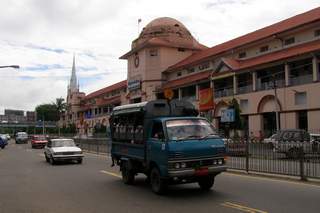
However, those are not the only buses that run the streets of Rangoon. The government has imported larger, newer (comparatively)second hand buses from Japan and Korea in recent years. They are far more larger than the older buses and more comfortable, but most of them are already quite worn out and break down as often.
One thing you might notice in Yangon public buses is that they are overcrowded most of the time. Passengers were packed into buses like herds of animals. But people are quite used to this and do not complain much.
Rangoon bus drivers and conductors are quite notorious for their rude behavior, carelessness and recklessness. More often than not, they shouted at the passengers push them roughly in and out of the bus, and break traffic laws easily. Although the punishment to this offense is a hefty fine and, for habitual offenders, a suspension of the driving/conductor license, most passengers accept this as a norm and don’t bother to complain.
Rangoon bus drivers and conductors are quite notorious for their rude behavior, carelessness and recklessness. More often than not, they shouted at the passengers push them roughly in and out of the bus, and break traffic laws easily. Although the punishment to this offense is a hefty fine and, for habitual offenders, a suspension of the driving/conductor license, most passengers accept this as a norm and don’t bother to complain.
Fare for buses is charged depending on the sectors you travel. The trips are usually subdivided into two or more sectors, and fare is collected for each sector. Usual fare for a sector is 20 kyats. Sometimes, the conductor pretends to forget a change and a passenger has to remind him for the change.